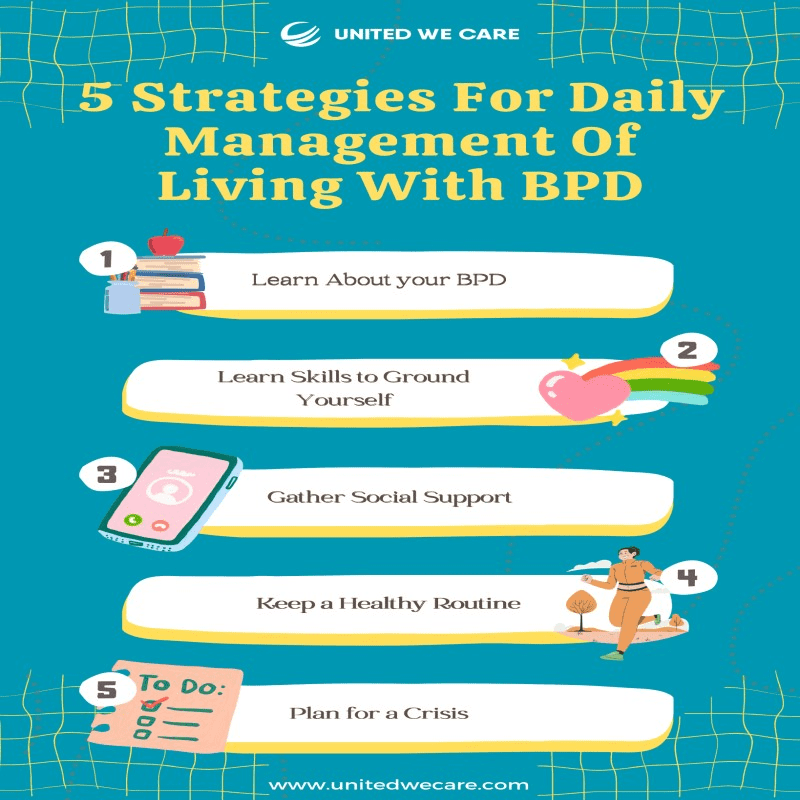Introduction
TW: Mention of Suicide and Self-Harm.
Recently, Pete Davidson, a famous American actor and comedian, opened up about his diagnosis of borderline personality disorder or BPD. Living with borderline personality disorder can be extremely challenging, confusing, and scary. It can also become difficult to maintain relationships and then deal with the intense feelings of abandonment that come with BPD. However, despite all this, when you get a diagnosis and start to understand what BPD is, a sense of control over it can come. Even Davidson described his experience of getting a diagnosis as a moment where someone has lifted all the weight off of him. This article delves into what it is like to live with borderline personality disorder and what you can do to manage it.
Symptoms of Living With Borderline Personality Disorder
Personality disorders are a specific group of disorders where the patterns of behavior and inner experiences are enduring, lead to distress or impairment, and are different from the cultural norms. Borderline Personality Disorder is a type of personality disorder where there is a pattern of instability and impulsivity. This instability is present in all areas, including relationships, sense of self, and emotions [1]. This is usually accompanied by an intense fear of abandonment and a tendency to harm oneself.
The symptoms of BPD include [1] [2]:
- Fear of Abandonment and an effort to avoid this real or imagined abandonment by various means.
- Intense and unstable relationships with friends, family, and other people. This can look like an intense attachment to a person and then suddenly feel that they don’t value you.
- Disturbance in identity is when you struggle with having a stable sense of self and feel confused about who you are or what you like. You may also change your appearance, career paths, or values frequently.
- Tendency of impulsivity, which can look like overspending, binge eating, risky sex, etc.
- Recurrent self-harm or suicidal behavior.
- Inability to regulate mood and frequent mood swings within a day.
- A feeling of emptiness that persists and does not go away.
- Issues controlling anger with frequent outbursts and fights.
- Paranoid thoughts, especially in times of stress.
If a person shows 5 or more of them in different contexts, then the clinician usually gives the diagnosis of BPD. It is important to note that these symptoms can overlap with other disorders, which is why clinicians have more than one session or test to give a diagnosis. Further, the severity, frequency, and duration of these symptoms might differ for different people. If you think you might be fulfilling some of the criteria but have not received a formal diagnosis, it is best to consult an expert before conclusion.
Treatments for Living With Borderline Personality Disorder
In recent history, a number of treatment modalities have come up for Borderline Personality Disorder. Of these, Dialectical Behavioral Therapy is a form of talk therapy that seems to have the most evidence behind it. However, clinicians also use other therapy modalities, medication, and, in some cases, hospitalization for BPD treatment. Treatment for BPD include:
- Dialectical Behavioral Therapy: In the 1990s, Marsha Linehan set the structure for DBT, a form of therapy that focuses on teaching clients skills to manage their symptoms. The skills in focus are mindfulness, interpersonal effectiveness, distress tolerance, and emotional regulation. Currently, clinicians find DBT as one of the most effective therapy modalities in treating BPD [3] [6].
- Other Talk Therapy Techniques: Clinicians also use other forms of therapy like Mentalization-based Therapy, Schema Focused Therapy, Transference Focused Psychotherapy, and systems training for emotional predictability and problem-solving (STEPPS) for BPD intervention [4] [6].
- Medication: There is no specific medication for BPD, but in cases that require medical intervention, doctors prescribe drugs for specific symptoms. For instance, antidepressants help in managing mood; neuroleptics can manage cognitive symptoms like paranoia, etc [5] [6]. Since many times other disorders like anxiety, depression, ADHD, bipolar disorder, eating disorder, and substance abuse are co-morbid conditions, sometimes doctors prescribe medication to manage these.
- Hospitalization: People with BPD are at risk for suicidal behaviors. In situations where a client attempts to harm themselves, hospitalization and monitoring becomes necessary [6].
5 Strategies for Daily Management of Living With BPD
Living with BPD can be a big challenge, but treatments like therapy can help you. However, coping in daily life is also a task and might require additional steps. Some things which can help you deal with BPD are [6] [7]:

- Learn About your BPD: It can be really useful to spend time learning about BPD, what causes it, and what some theories are behind it. Another key word here is “your”. This means that you learn about how BPD is affecting you and what your triggers are. Once you start getting aware, it will become easier to deal with it.
- Learn Skills to Ground Yourself: A lot of times, living with BPD is like living in a storm. Learn skills like mindfulness, breath work, and grounding using your senses to situate yourself in the here and now. This can help with emotional instability and impulsivity.
- Gather Social Support: Try to talk about your BPD with people close to you. Also, surround yourself with people who understand what it is and how it affects you. You can think about joining support groups as well.
- Keep a Healthy Routine: Something as simple as keeping a healthy routine with regular meals, exercise, and sleep can help you lower your emotional vulnerability. It will also keep other issues like depression at bay and restore some stability in your life.
- Plan for a Crisis: You can do this with your therapist, or you can try it alone. Basically, plan in advance a series of steps for the times you feel triggered. This is especially useful in dealing with suicidal thoughts and self-harm behaviors. You can also make a crisis plan for when feelings of being abandoned or distressed are high.
An additional reminder here is that it is not your fault that you have BPD. It is difficult, and healing takes time. However, going on the journey of healing and self-awareness is your responsibility towards yourself and your loved ones.
Conclusion
Borderline Personality Disorder is a complex psychological disorder that essentially affects all areas of your life. It can make you feel like you are living without a center and everything is unstable. However, there are various treatment options available. Treatments like Dialectical Behavioral Therapy work really well in helping people manage symptoms of BPD. At the same time, there are a number of coping strategies you can employ to deal with it in your daily life. Start by learning about the disorder itself and then learn essential skills to manage it. Remember that with time, you can learn to deal with these problems and lead a healthier life.
If you are someone who is struggling with BPD, contact the experts at United We Care. At United We Care, we are committed to providing you with the best solutions for your well-being.
References
[1] Diagnostic and Statistical Manual of Mental Disorders: DSM-5. Arlington, VA: American Psychiatric Association, 2017.
[2] “Borderline personality disorder: Causes, symptoms & treatment,” Cleveland Clinic, https://my.clevelandclinic.org/health/diseases/9762-borderline-personality-disorder-bpd (accessed Oct. 3, 2023).
[3] J. M. May, T. M. Richardi, and K. S. Barth, “Dialectical behavior therapy as treatment for borderline personality disorder,” Mental Health Clinician, vol. 6, no. 2, pp. 62–67, 2016. doi:10.9740/mhc.2016.03.62
[4] L. W. Choi-Kain, E. F. Finch, S. R. Masland, J. A. Jenkins, and B. T. Unruh, “What works in the treatment of borderline personality disorder,” Current Behavioral Neuroscience Reports, vol. 4, no. 1, pp. 21–30, 2017. doi:10.1007/s40473-017-0103-z
[5] K. Lieb, M. Zanarini, C. Schmahl, M. Leinehan, and M. Bohus, “Borderline personality disorder,” Lancet, 2004. Accessed: Oct. 3, 2023. [Online]. Available: https://ce-classes.com/exam_format/Borderline-Personality-Disorder.pdf
[6] “Borderline personality disorder,” Mayo Clinic, https://www.mayoclinic.org/diseases-conditions/borderline-personality-disorder/diagnosis-treatment/drc-20370242 (accessed Oct. 3, 2023).
[7] M. Smith and J. Segal, “Borderline personality disorder (BPD),” HelpGuide.org, https://www.helpguide.org/articles/mental-disorders/borderline-personality-disorder.htm (accessed Oct. 3, 2023).









